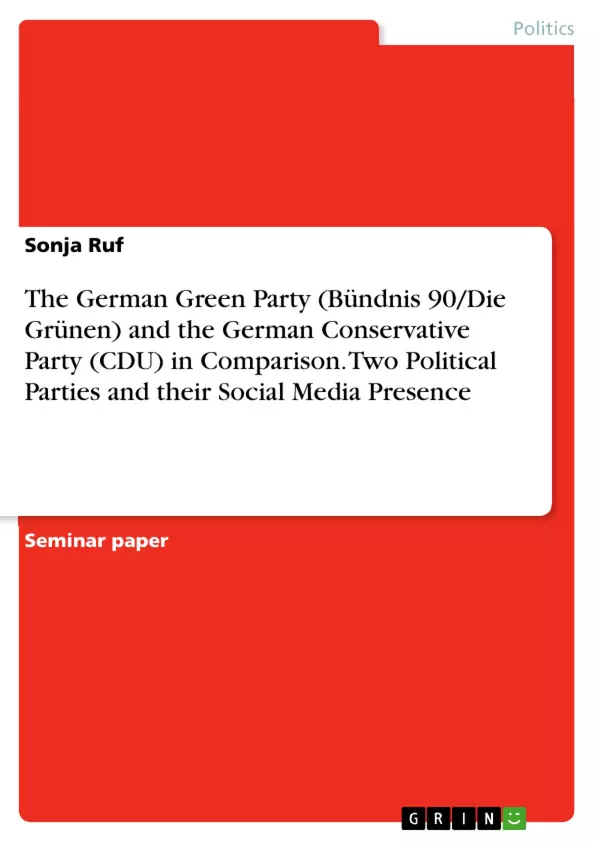The following essay would like to approach this assumption on the basis of a comparison based on the online- and social media presence of the two parties. How do the green party differ in their online- and social media presence from the conservative party and what effects might this have in terms of communicating with their own members leading to a more efficient and successful party-organization and therefore probably currently gaining higher voter-numbers? Following this logic, the overarching thesis for the following essay is: The german green party (Bündnis 90/Die Grünen) has a better way to inform, involve, connect and mobilize their members through their online- and social media presence than the german conservative party (CDU).
Table of Contents
- 1 INTRODUCTION
- 2 LITERATURE REVIEW AND RESEARCH DESIGN
- 3 COMPARISON
- 3.1 DIMENSION: INFORMING
- 3.2 DIMENSION: INVOLVING
- 3.3 DIMENSION: CONNECTING AND MOBILIZING
- 4 CONCLUSION
Objectives and Key Themes
This essay aims to compare the online and social media presence of two German political parties: the green party (Bündnis 90/Die Grünen) and the conservative party (CDU). By analyzing these platforms, the essay investigates whether the green party is more effective at informing, involving, connecting, and mobilizing its members than the conservative party. This analysis will be guided by the four functions of political communication: informing, involving, connecting, and mobilizing.
- The impact of new information and communication technologies on political communication and party functions in Germany
- The effectiveness of online and social media platforms in communicating political information and engaging with members
- The potential correlation between a party's online presence and its success in elections
- The concept of 'early adopters' and their role in digitalization and disruptive innovation within political parties
- The relationship between political parties and their membership base, especially in the context of online and social media communication
Chapter Summaries
The first chapter provides an introduction to the research question, focusing on the potential divergence between political reality and online popularity. The essay's central thesis is that the German green party excels at informing, involving, connecting, and mobilizing its members through their online and social media presence compared to the conservative party. The essay explores reasons for this potential difference, including the green party's role as "early adapters" in digitalization and their perceived greater understanding of their own party base.
Chapter two delves into the literature review and research design, highlighting key studies on the use of online and social media platforms by political parties in Germany. It outlines the four functions of political communication – informing, involving, connecting, and mobilizing – which form the basis for the essay's analysis. The research design aims to investigate how the green party and the conservative party perform in fulfilling these four functions through their online and social media presence.
Keywords
This essay focuses on the online and social media presence of political parties in Germany, particularly the green party (Bündnis 90/Die Grünen) and the conservative party (CDU). The key concepts explored include digitalization, disruptive innovation, online and social media communication, political party functions, informing, involving, connecting, mobilizing, and the relationship between parties and their membership base. The analysis draws upon existing research on the use of online and social media platforms by political parties, highlighting the impact of these platforms on political communication and party performance.
- Quote paper
- Sonja Ruf (Author), 2022, The German Green Party (Bündnis 90/Die Grünen) and the German Conservative Party (CDU) in Comparison. Two Political Parties and their Social Media Presence, Munich, GRIN Verlag, https://www.hausarbeiten.de/document/1354044


